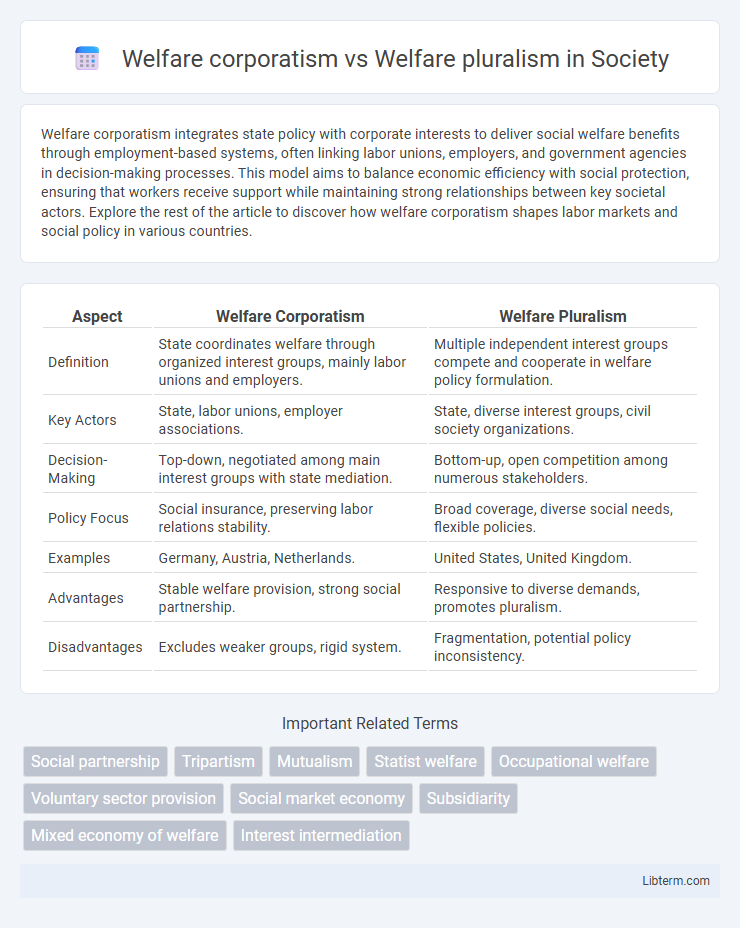Welfare corporatism integrates state policy with corporate interests to deliver social welfare benefits through employment-based systems, often linking labor unions, employers, and government agencies in decision-making processes. This model aims to balance economic efficiency with social protection, ensuring that workers receive support while maintaining strong relationships between key societal actors. Explore the rest of the article to discover how welfare corporatism shapes labor markets and social policy in various countries.
Table of Comparison
| Aspect | Welfare Corporatism | Welfare Pluralism |
|---|---|---|
| Definition | State coordinates welfare through organized interest groups, mainly labor unions and employers. | Multiple independent interest groups compete and cooperate in welfare policy formulation. |
| Key Actors | State, labor unions, employer associations. | State, diverse interest groups, civil society organizations. |
| Decision-Making | Top-down, negotiated among main interest groups with state mediation. | Bottom-up, open competition among numerous stakeholders. |
| Policy Focus | Social insurance, preserving labor relations stability. | Broad coverage, diverse social needs, flexible policies. |
| Examples | Germany, Austria, Netherlands. | United States, United Kingdom. |
| Advantages | Stable welfare provision, strong social partnership. | Responsive to diverse demands, promotes pluralism. |
| Disadvantages | Excludes weaker groups, rigid system. | Fragmentation, potential policy inconsistency. |
Introduction to Welfare Models
Welfare corporatism emphasizes a structured collaboration between the state, employers, and labor unions to deliver social benefits, reflecting a top-down approach to social policy. Welfare pluralism, in contrast, features multiple independent actors, including voluntary organizations and market forces, shaping diverse and decentralized welfare provision. These fundamental models illustrate contrasting mechanisms for distributing social protection and managing societal risks within modern welfare states.
Defining Welfare Corporatism
Welfare corporatism is a social policy model where the state collaborates closely with organized interest groups such as labor unions and employer associations to regulate welfare provisions. This system emphasizes negotiated agreements between these groups to determine benefits and social protections, ensuring inclusive representation and coordination. Unlike welfare pluralism, which allows multiple competing groups to influence welfare independently, corporatism promotes structured cooperation and centralization in welfare decision-making.
Understanding Welfare Pluralism
Welfare pluralism emphasizes the shared responsibility for social welfare among the state, market, and voluntary sectors, promoting diverse and decentralized welfare provision. It contrasts with welfare corporatism, where centralized cooperation dominates between the state and specific interest groups. Understanding welfare pluralism involves recognizing how multiple actors contribute to social protection, fostering flexibility and responsiveness to diverse societal needs.
Historical Evolution of Welfare Systems
Welfare corporatism originated in early 20th-century Europe, intertwining social insurance with labor unions and employer associations to maintain social order and political stability. Welfare pluralism emerged later as a response to increased social diversity and individualism, promoting multiple welfare providers, including state, market, and voluntary sectors. The historical evolution reflects a shift from centralized, occupation-based benefits in corporatism to fragmented, choice-driven welfare arrangements under pluralism.
Core Principles and Key Stakeholders
Welfare corporatism centers on collaboration between the state, employers, and labor unions as key stakeholders, emphasizing structured partnership and centralized negotiation to deliver social welfare benefits. The core principle involves a tripartite arrangement ensuring labor market regulation and social protection through collective agreements. In contrast, welfare pluralism prioritizes multiple, decentralized actors including diverse interest groups, voluntary organizations, and the market, promoting competition and choice in welfare provision with less state intervention.
Comparative Analysis: Corporatism vs Pluralism
Welfare corporatism centralizes social policy decision-making within elite, state-linked organizations, ensuring coordinated benefits through structured negotiation among government, employers, and labor unions. Welfare pluralism disperses power among multiple interest groups and relies on competitive advocacy, leading to more diverse but less coordinated social policies. Comparative analysis reveals corporatism's strength in stability and uniform coverage contrasts with pluralism's adaptability and responsiveness to varied social demands.
Strengths and Weaknesses of Each Model
Welfare corporatism centralizes social policy decision-making through collaboration between the state, employers, and labor unions, ensuring coordinated and stable welfare provision but often limiting pluralistic representation and flexibility. Welfare pluralism promotes diverse interest group involvement and decentralized policy-making, fostering adaptability and inclusiveness but risking policy fragmentation and inefficiencies. Corporatism excels in stability and uniformity, while pluralism advantages lie in democratic participation and responsiveness to varied social needs.
Impact on Social Equity and Inclusion
Welfare corporatism often emphasizes state and organized labor collaboration, which can lead to more uniform social benefits but may exclude marginalized groups lacking representation in formal sectors. Welfare pluralism encourages diverse actors, including non-governmental organizations and community groups, facilitating broader social inclusion and responsiveness to varied needs. The pluralistic model generally promotes greater social equity by addressing the interests of multiple social groups beyond traditional labor frameworks.
Case Studies: Global Applications
Welfare corporatism, exemplified by Germany's integration of labor unions and employer associations in social policy decision-making, contrasts with welfare pluralism as seen in the United States, where multiple competing interest groups influence social welfare programs. In Nordic countries like Sweden, welfare corporatism fosters strong state coordination with labor and employer groups, promoting comprehensive social protection systems. Conversely, countries such as the United Kingdom showcase welfare pluralism through decentralized welfare provision managed by diverse non-governmental organizations and market actors, reflecting varied stakeholder involvement.
Future Prospects and Policy Implications
Welfare corporatism, characterized by strong state intervention and collaboration with labor and employer groups, faces challenges adapting to increasing social diversity and global economic pressures, necessitating policy reforms that promote inclusivity and flexibility. Welfare pluralism, emphasizing multiple actors including NGOs, private sectors, and local governments, offers resilience through decentralized decision-making but requires stronger coordination mechanisms to ensure equitable service delivery. Future policy implications highlight the need to integrate digital innovation and sustainable financing models to enhance responsiveness and coverage in evolving welfare states.
Welfare corporatism Infographic

 libterm.com
libterm.com